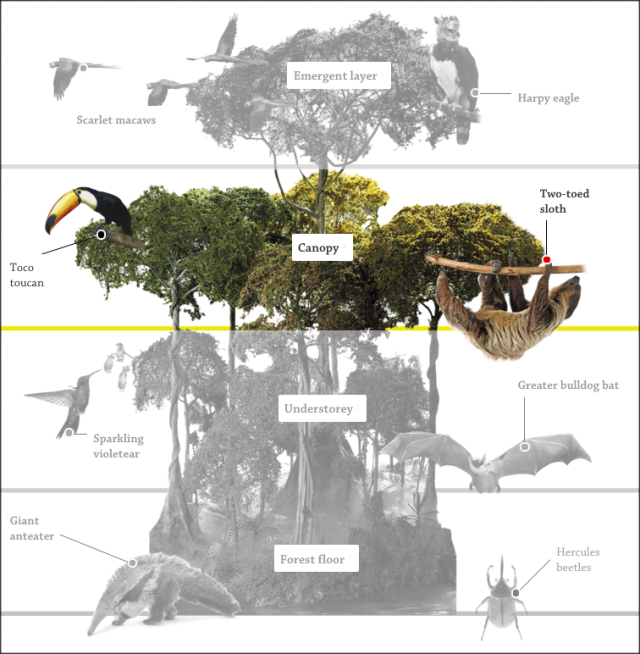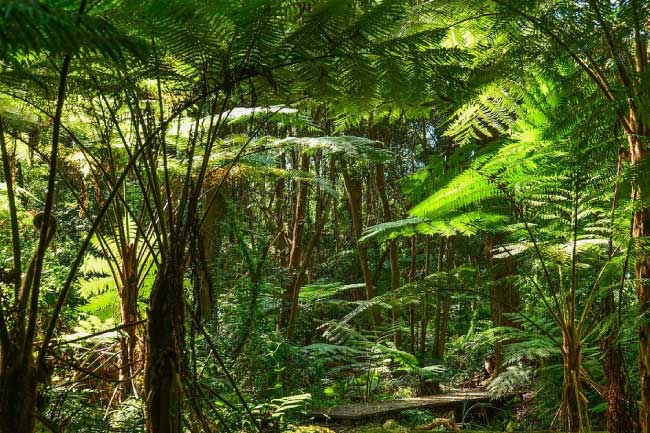Social Studies has often been one of my favorite subjects. Learning about places and things around the world. Tropical Rainforest are some of those things that I love to learn about but most likely will never see. Tropical Rainforest only exist around the equator. Mostly because it is the only region on the planet that hold conditions that rainforest find desirable
Tropical Rainforests are humid, warm and wet with rainfall totaling 8-14 feet per year. The unique climate conditions are what helps make rainforest so fascinating. With four distinct rainforest layers of vegetation ----
- The Emergent
- The Canopy
- The Understudy
- The forest floors
The emergent layer is where the tallest trees come through the dense canopy layer, pointing their large pointy tops through. The top trees enjoy the greatest amount of sunlight, therefore they must be able to endure high temps, low humidity and strong winds. These tall trees will emerge to tower over the rainforest at an average of 200 feet above the forest floor. Tree trunks will measure up to 16 feet round. These large trees are primarily hardwood evergreens.
Birds and insects in the emergent layer are important to the rainforest as they are ones that help pollinate the plants. Flowers are not plentiful in the emergent layer but orchids shine through from the lower below. The Brazil nut tree stand high above the emergent layer.
The emergent layer does house animals but smaller, lighter ones that can easily move around tree to tree Spider monkeys and sloths live in this layer of the rainforest. The humming bird and a member of the parrot family the Macaw both call the emergent layer home as well. THe goliath bird eating tarantula comes out during the rainy season and hunts small animals of the emergent layer. In addition, the harpy eagle, bats, snakes, butterflies and a variety of insects call the rainforest emergent layer home.
The canopy layer of the rainforest is where most of the trees come together to form a canopy approximately 60 to 90 feet above the forest floor. Here is where other plants intertwine with the tree branches and 90% of the organisms living in the rainforest will be found. Light hits this layer may result in leaves at the top being burned
The canopy layer lies right beneath the Emergent Layer of the rainforest and above the lower level understory and floor. Most of the sunlight at the canopy stage will be absorbed here blacking out much of the lower levels. Likewise much of the rain is captured by the Canopy layer allowing very little to reach plants below.
Animals located at the canopy layer of rainforest include monkeys, bats, snakes, tree frogs and toucans. Each of the animals eat the fruit and seeds from trees that can be found. The trees at this layer also offer the many animals good shelter. Animals at this level must be able to fly, jump, glide, and hop to get between the gaps in the trees.
The rainforest is full of vines with climbing vines known as Lianas living in the canopy layer where they attach to trees and grow towards the sunlight. The vines protect and supports top heavy trees. The vines are also cut and used to make items such as baskets and wicker furniture. The canopy level of the rainforest also support orchids, mosses, ferns and lichens
The tropical rainforest understory layer only receives 2 to 15 % of sunlight that falls on the canopy layer. The understory is a rather dark place that is open with young trees and leafy herbaceous plants only demand low light. Many popular houseplants are found in this part of the rainforest.
The understory layer accumulates lots of insects because of the very hot and wet atmosphere. Bees, stick insects, bullet ants, beetles, butterflies and mosquitoes are all in abundance at this level. Because of the great number of insects birds, geckos and monitors are there as well. Common animals that can be seen here include bats, monkeys, snakes, lizards, jaguars, and frogs. Many reptiles camouflage in this area to hide and live life as well. Food is scarce in this part of the rainforest so animals all compete for their needs.
Plants growing in the Understory layer re mostly small trees, low lying shrubs, ferns, climbing plants and native bananas. There are few flowering plants in this layer with the ones that do exist the colors are bright and strong scented
The forest floor is very dark and little grows in this area. Plants adapted to very low light, fallen leaves, seeds, fruits and branches that are decomposing are found on the forest floor. The forest floor is where the process of decomposition takes place.
Decay is a rapid process here on the forest floor because of the dark and moist conditions. Every living organism has different qualities organisms known as Saprophytes recycle and feed on decaying matter. There will be something that will eat them, then the food chain continues. The circle of life is how both plants and animals survive. This in turn begins the food chain, or the circle of life, for both plants and animals to survive.
The floor layer is where the larger animals of the rainforest are found. Both carnivores and herbivores The continent helps determine what animals may be found, among them are jungle cats. Jungle cats live in different rainforest but none of the mlive in the Australians rainforests. Whether it be tigers, pumas, leopards or jaguars.
Other animals found on the floor of the rainforest include elephants, mongoose, armadillos, gorillas and more. A grand number of insects in a vast variety along with amphibian and reptile species can be located on the forest floor. You can also find large spiders , scorpions, snakes and army ants on the rainforest floor. These dangerous species find that food is plentiful at the bottom of the rainforest.
I can recall learning about the rainforest in 4th grade when I had Helen Anderson for a school teacher. In the back of her home she had a "forest" that was much like the rainforest in that it held "layers" within it as well. What a great memory I hope you learned some by reading my post as well.
retweet post here shared on google + here






)
No comments:
Post a Comment
I love comments so if you have a minute leave me your thoughts on the above post